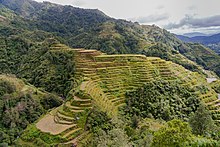Rice terraces in the Filipino Cordillera
The rice terraces in the Philippine Cordillera are a special landscape feature of the Philippine province of Ifugao in the Cordillera in the northeast of the island of Luzón . Since 1995, they are on the UNESCO list of World Heritage Sites .
description
The terraces, which cover a large part of the province, are an example of the extensive shaping of a landscape by man. For probably 2000 years, the mountain slopes at an altitude of 700 to 1500 meters have been terraced with retaining walls and irrigated for the cultivation of rice and vegetables. All areas are used up to a slope of 70 °. The walls are the only pre-colonial stone structures in the Philippines.
The construction and maintenance of the terraces are still subject to the traditional rules of the indigenous Ifugao . Private forests ( muyong ) are maintained above the fields in order to secure the water supply. No terrace is allowed to stop the flow of water to the next lower level, the entire amount of water is evenly distributed through dams, ditches and bamboo tubes that are jointly owned. The retaining walls, on average two meters high, follow the contour of the terrain and are made of rubble stones. Behind them, the ground is first filled with rubble, into which channels for drainage are embedded. A highly compacted layer of soil then follows about one meter below the final ground level. The top 20-30 cm are then the muddy, heavily plowed arable soil.
Traditionally, all terraces are family owned. Property rights are governed by the rules of tribal law and are enforced by holy men (Mumbaki) .
Monument protection
In 1991 the rice terraces were declared a national treasure, and from 1994 the Ifugao Terrace Commission was responsible for their preservation . In 1995 UNESCO declared five individual areas to be World Heritage Sites:
- two areas in the township of Banaue ( Battad and Bangaan ),
- in Mayoyao Township ,
- in the township of Kiangan (Nacadan)
- and in Hungduan Township .
In 2001 the rice terraces were entered on the Red List of World Heritage in Danger. With the Ifugao becoming less interested in their traditional culture, the rice terraces are also increasingly neglected. More and more farmers are cultivating the cultivation only as a show for the tourists, for the irrigation systems and flood protection, concrete structures are increasingly being used that take no account of the traditional systems. The central organization of the World Heritage site via the Terrace Commission also leads to conflicts of interest with the local administrative structures, which do not benefit directly from the income from tourism. The Ifugao World Heritage Office, located in the province, has been responsible for the administration since 2006 .
literature
- Melisa Therese, N. Malingan-Sapdoy: The evolving management of the rice terraces of the philippine cordilleras, focus on the Ifugao rice terraces . In: 2nd ASEAN Heritage Parks Conference and 4th regional Conference on Protected Areas . Kota Kinabalu / Sabah Malaysia 2007 (English, ( page no longer available , search in web archives: aseanbiodiversity.org )).
Web links
- Banaue Municipality Tourist Office
- Entry on the UNESCO World Heritage Center website ( English and French ).
- Status report 2006 of the World Heritage Committee (PDF; 184 kB), p. 4 ff. (English)
Individual evidence
- ↑ a b UNESCO World Heritage Center: Rice Terraces of the Philippine Cordilleras. Retrieved on August 24, 2017 .
Coordinates: 16 ° 56 ′ 2 ″ N , 121 ° 8 ′ 12 ″ E


